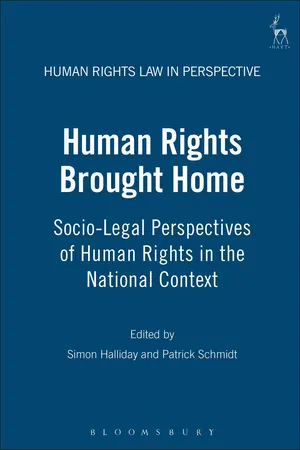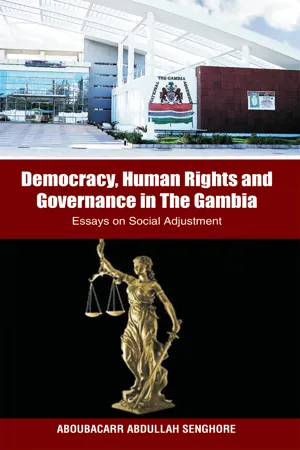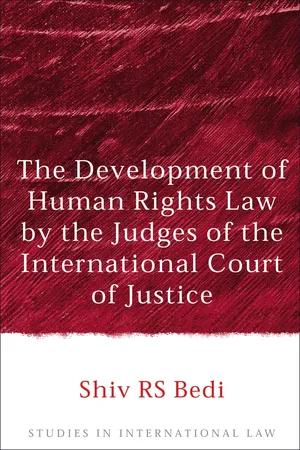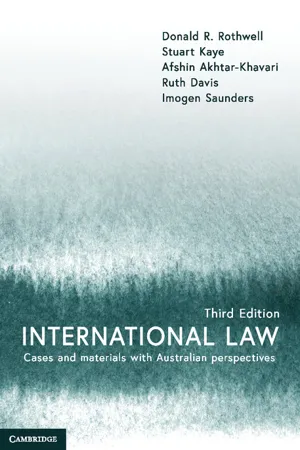Law
Human Rights Law
Human rights law encompasses the body of international and domestic laws that protect and promote the fundamental rights and freedoms of individuals. It includes treaties, conventions, and domestic legislation that address issues such as equality, non-discrimination, freedom of speech, and the right to a fair trial. Human rights law aims to ensure that all individuals are treated with dignity and respect.
Written by Perlego with AI-assistance
Related key terms
1 of 5
9 Key excerpts on "Human Rights Law"
- eBook - PDF
- Hurst Hannum(Author)
- 2016(Publication Date)
Chapter 1 A n Overview of International Human Rights Law Richard B. Bilder The international human rights movement is based on the concept that every nation has an obligation to respect the human rights of its citizens and that other nations and the international community have a right, and responsibility, to protest if states do not adhere to this obligation. International Human Rights Law consists of the body of in-ternational rules, procedures, and institutions developed to imple-ment this concept and to promote respect for human rights in all countries on a worldwide basis. While international Human Rights Law focuses on international rules, procedures, and institutions, it typically requires at least some knowl-edge of and sensitivity to the relevant domestic law of countries with which the practitioner is concerned. In particular, one must be aware of national laws regarding the implementation of treaties and other international obligations, the conduct of foreign relations, and the protection accorded by domestic law to human rights. Indeed, since international law is generally applicable only to states and does not normally create rights directly enforceable by individuals in national courts, international Human Rights Law can be made most effective only if each state makes these rules part of its own domestic legal system. Many international human rights activities are directed at en-couraging countries to incorporate international human rights stan-dards into their own internal legal order in this way. Thus, the work of international Human Rights Lawyers and national human rights (or civil rights) lawyers is closely related and often overlaps. In practice, the differences between international human rights and national civil rights often lie more in emphasis than substance. Concern for human rights rarely begins or ends at any single nation's boundaries, and effective action to protect and promote human rights, - eBook - PDF
Human Rights Brought Home
Socio-Legal Perspectives of Human Rights in the National Context
- Simon Halliday, Patrick Schmidt, Simon Halliday, Patrick Schmidt(Authors)
- 2004(Publication Date)
- Hart Publishing(Publisher)
Further, though human rights earlier had largely been the province of international lawyers, in the twenty-first century it has become an instrument of domestic law across the common law and civil law world alike. Although human rights retains considerable vitality as an aspect of international law, with recent applications from Rwanda to Yugoslavia, this transformation has brought the concept more completely within complex and advanced legal systems, some of which have recognised some notions of civil and political rights for centuries. In addition to its history in international law and politics, its influence on popular consciousness, and its place in a number of intellectual disci-plines, then, ‘human rights’ has now become a concept of domestic law and may be explored and analysed within this framework. This has had a clear impact on legal research. Even before the full blossoming of domes-tic human rights adjudication in the UK, we witnessed the start of the now-explosion of legal scholarship exploring the implications of human rights for various areas of domestic law. As parties have raised human rights claims and judges have begun to develop a domestic human rights jurisprudence, the significance of human rights to domestic law and pol-icy making has been all the more obvious. However, just as the reception of international human rights norms into domestic law raises a host of doctrinal questions, so too it raises unavoidable socio-legal questions in the national context. In the wake of such a seismic shift in the legal and constitutional landscape, a full and pressing socio-legal research agenda emerges. However, socio-legal work on human rights in the national con-text has failed to match the pace and enthusiasm of doctrinal work, par-ticularly in terms of the empirical socio-legal evidence necessary to assess the claims made for human rights as legal practice. - eBook - PDF
- David Hayton(Author)
- 2000(Publication Date)
- Hart Publishing(Publisher)
Constitutional and Human Rights Law CONOR GEARTY AND ADAM TOMKINS Introduction There is a sense in which every chapter in this book could be about Human Rights Law. If we had to make one prediction about the future of UK law over the coming two decades or so it would be that rights-talk (and, increasingly, rights law) will figure ever more intrusively. Human rights might not come to dominate UK law, but they are set to become a domineering presence over it. We write here under the heading: Constitutional and Human Rights Law. The noun law reflects our belief that Human Rights Law (as opposed to human rights) is a deeply technical subject, often quite distant from the noble political ideas of radical eighteenth century philosophy which fathered it. The constitutional dimension reflects our belief that a collection such as this should include at least some passing reference to the constitution, but more broadly we felt that, as public lawyers, one of the more arresting lessons of the Human Rights Act 1998 has already been how much the Act speaks to certain other areas of law more fundamentally than it appears to relate to constitu-tional law. While it might initially have been assumed that it would be consti-tutional lawyers who would embrace the Human Rights Act as a new aspect of their discipline, on further analysis it turns out that family lawyers, criminal procedure lawyers, and specialists in the law of evidence will all have to con-front the Human Rights Act more immediately and more urgently than will constitutional lawyers. But one critical task which the Human Rights Act will perhaps set constitutional lawyers, more pressingly than they are used to, is to crystallise the scope of their subject. In a sense, therefore, there is a critical ten-sion in our title, which raises the two questions on which we focus in this chap-ter. - eBook - ePub
Democracy, Human Rights and Governance i
Essays on Social Adjustment
- Abdullah Senghore(Author)
- 2023(Publication Date)
- CENMEDRA(Publisher)
30 Finally, a closer look at the five fundamental values that, according to Muslim jurists, Shariah has been revealed to protect and preserve, clearly shows that Islamic law has in actual fact adequately guaranteed the protection and ensured the means of actualization of all fundamental human rights and basic freedoms incorporated in the international human rights conventions and treaties of contemporary times i.e. the protection of life, religion, intellect, progeny and property has definitely included all the civil, political, economic, social and cultural rights protected by the modern international law of human rights and various national laws of the nation states of contemporary times.I.d. Can the Concept of Human Rights be Universally and Comprehensively Defined? And What Significance will that Definition Make?As the above discussion of the nature of rights reveals there can be no single universal and comprehensive definition for the concept of human rights. The various philosophical perspectives just highlighted above stand to contradict one another. So to give a single definition comprehensive enough to be accepted by all is out of the question. Similarly, the continuing debate and controversy between the theories of universality and cultural relativism over the scope and relevance of human rights is another factor ruling out the possibility of providing such a definition. While any definition by the proponents of the universality theory would stress the universal, indivisible, interdependent and interrelated character of human rights and that they have to be placed beyond the limits of domestic jurisdiction, the cultural relativists would advance a definition which emphasizes the need to consider human rights in their ideological, regional and national context and on the principle of respect for and non interference in the internal affairs of a sovereign state. However, given that the concept or term “rights” is used to describe a variety of relationships the following description of the concept may be recognized (although it sounds influenced by the theory of natural rights): Human Rights are those fundamental values inherent in every individual human being on the basis of humanity and recognized by law both domestic and international. - Shiv R.S. Bedi(Author)
- 2007(Publication Date)
- Hart Publishing(Publisher)
This relationship is not diffi-cult to discover between the human right(s) of a person, or a group of persons, and the State, or any governing entity. Sometimes the term right is used to indicate an immunity from having a legal status altered. Sometimes it also indicates a privilege to do something. And also sometimes right refers to a power to create a legal rela-tionship. According to Shestack: Sometimes scholars classify civil and political rights as types of immunities since they protect against encroachments of govern-ment. They are restraints on government in the nature of a command: ‘Thou shall not’. Generally, such negative restraints can be secured by fairly simple legislation. Economic, social, and cultural rights, on the other hand, are ‘rights’ in which affirmative action by the government is necessary. Therefore, they are viewed as claims upon the governments which may or may not be realized depending on such matters as availability of resources and other conditions. Relationship between Human Rights and International Law 59 74 Encyclopedia of International Law , vol 2, p 886. Article 29, paragraph 1, of the 1948 UN Universal Declaration of Human Rights stipulates: ‘Everyone has duties to the community in which alone the free and full development of his personality is possible’. Hence, according to Morsink, human rights in ‘Article 29 . . . admits that rights are balanced by and are correlative with duties. Thus, human rights even when conceived of as natural rights, are not unlimited’. 75 Since there cannot be a right without a remedy, Hohfeld’s theory of jural rela-tions has certainly something to offer to the law of human rights in its various forms and norms. Judge Higgins’ theory of integrity and dignity of human being at once elevates individual human being to the status of an equal partner, along with the State, in international law.- eBook - PDF
International Law
Cases and Materials with Australian Perspectives
- Donald R Rothwell, Stuart Kaye, Afshin Akhtar-Khavari, Ruth Davis, Imogen Saunders(Authors)
- 2018(Publication Date)
- Cambridge University Press(Publisher)
But these freedoms are much less real to him than his freedom to be exploited. Only as his poverty is reduced will his existing political freedom become properly meaningful and his right to human dignity become a fact of human dignity. 34 This might be best summed up as a call for the right to development, which has received its own share of attention in the international human rights discourse. 35 Do you agree that a hierarchy of rights exists among civil, political, social, cultural and economic rights or are they indivisible and interdependent? 9.3.2 Different kinds of human rights There are a significant number and variety of international instruments, opinions and practices that seek to define the details of the prevalent norms of the human rights discourse internation- ally and establish the basis for its functional operation. In addition to the UDHR, some of the other significant human rights instruments are the: • 1966 International Covenant on Civil and Political Rights (ICCPR) 36 • 1966 International Covenant on Economic, Social and Cultural Rights (ICESCR) 37 • four Geneva Conventions of 1949 that form the core of human rights obligations during armed conflict 38 • 1950 European Convention on Human Rights 39 • 1969 American Convention on Human Rights 40 • 1981 African Charter on Human and Peoples’ Rights. 41 The last three are included in this list because of the impact they have had in establishing regional customary law approaches to the human rights discourse. In addition to these general agreements, the international community has elaborated, interpreted or expanded on civil, political, cultural, economic, social and solidarity rights through specialised conventions. These ................................................................................................................................................................................................................................ - eBook - PDF
- Leanne Weber, Elaine Fishwick, Marinella Marmo(Authors)
- 2017(Publication Date)
- Red Globe Press(Publisher)
Far from bypassing state sovereignty according to Arendt’s vision, this framework operates within a system of independent sovereign nations, creating an ongo-ing tension between individual and group rights and the rights of states. Chapter 2 provides a basic overview of the current system of international Human Rights Law. Additional readings and materials Universal Declaration of Human Rights Available at: http://www1.umn.edu/humanrts/instree/b1udhr.htm. The Origins and Idea of Human Rights 17 Constitution of the United States of America Available at: http://www.archives.gov/exhibits/charters/constitution.html International Covenant on Economic, Social and Cultural Rights Available at: http://www1.umn.edu/humanrts/instree/b2esc.htm. International Covenant on Civil and Political Rights Available at: http://www1.umn.edu/humanrts/instree/b3ccpr.htm. Cushman, T. (2012) Handbook of Human Rights , Abingdon: Routledge. Dembour, M. (2006), Who Believes in Human Rights? Reflections on the European Convention , Cambridge, Cambridge University Press. Donnelly, J. (2002) Universal Rights in Theory and Practice , Ithaca, NY: Cornell University Press. Douzinas, C. (2000) The End of Human Rights: Critical Legal Thought at the Turn of the Century , Oxford: Hart Publishing. Kalin, W. (2013) ‘ Late modernity: human rights under pressure? ’ Punishment and Society 15(4): 397—411. Locke, J., The Second Treatise of Government (first published 1689). Available as a free download from Project Gutenberg at http://www.gutenberg.org/ebooks/ 7370. Neier, A. (2012) The International Human Rights Movement: A History , Princeton, NJ: Princeton University Press. Nickel, J.W. (1987) Making Sense of Human Rights: Philosophical Reflections on the Universal Declaration of Human Rights , Berkeley, CA: University of California Press. Osiatynski, W. (2009) Human Rights and Their Limits , Cambridge: Cambridge University Press. Court case cited Muir v The Queen [2004] HCA 21 (Australia). - eBook - ePub
- Bruce Bueno de Mesquita(Author)
- 2013(Publication Date)
- CQ Press(Publisher)
9 Human Rights, International Law, and Norms Skulls are lined up at a memorial site in rural Rwanda. OVERVIEW International treaties carry the force of law whereas many international organizations do not. Human rights constitutes one of the most important arenas in which treaties are used to try to improve people’s quality of life. Whether international law and treaties in particular succeed in advancing human rights is hotly debated. The bulk of the systematic evidence is not encouraging. Treaty design and ratification are strategic, endogenous processes so much of what we observe about compliance and ratification reflects selection effects over governmental preferences and expectations. Arguments for equal status for civil liberties, political rights, economic rights, and social rights provide cover for dictators who do not wish to jeopardize their hold on power by granting civil liberties and political rights to their citizens. Poverty is not inherently an impediment to human rights. Human rights, however, help alleviate poverty. Improving quality of life for the world’s poor probably requires giving greater priority to civil liberties and political rights and lower priority to economic rights. W e have now learned some depressing news about international organizations and saw a bit of hope to improve cooperative policy outcomes by the end of chapter 8. Chapters 7 and 8 emphasized how weak the connection is between what signatories promise to do and what they actually do. Many of the international organizations and international agreements we met have norms of conduct to back them up. Others, like the United Nations or the World Trade Organization (WTO), each of which includes a judicial branch, are said to be supported by the force of law - eBook - PDF
- Ilias Bantekas, Lutz Oette(Authors)
- 2016(Publication Date)
- Cambridge University Press(Publisher)
The question of whether the individual or the state is, or should be, the true subject of international law, and to what degree the subject status of individuals is dependent on the state, has been widely debated. 130 What matters for practical purposes is that treaties and customary international law recognise individuals as rights- holders, and hence as subjects. Significantly, the recognition of rights is independent of the existence of available remedies, i.e. the fact that an individual may not be able to claim his or her right before any body neither deprives the right of its quality nor the individual of his or her status as a subject. 131 Rights can be divided into several categories with respect to their: (1) origin and source of validity (natural and positive rights – see Chapter 1); (2) subject or right-holder (individual and group rights); (3) subject matter (civil and political rights; economic, social and cultural rights; collective rights); (4) type (negative or positive rights); and (5) nature (absolute and other, particularly qualified rights). Most of the rights recognised in international human rights treaties are conceptualised as individual rights. This harks back to the notion that human beings have rights by virtue of their humanity, which was traditionally understood to apply to individuals only. While some of the most prominent human rights in the early twentieth century had a collective dimension (for example, minority rights), these rights were understood to belong to the individual members of minorities, not to any collective entity. 132 Several objections have been raised against the recognition of collective rights, ranging from the position that human rights can by definition only be vested in the individual, to a number of pragmatic concerns.
Index pages curate the most relevant extracts from our library of academic textbooks. They’ve been created using an in-house natural language model (NLM), each adding context and meaning to key research topics.








